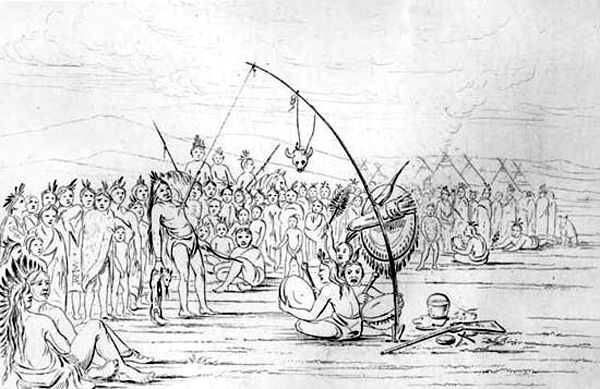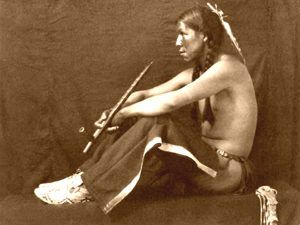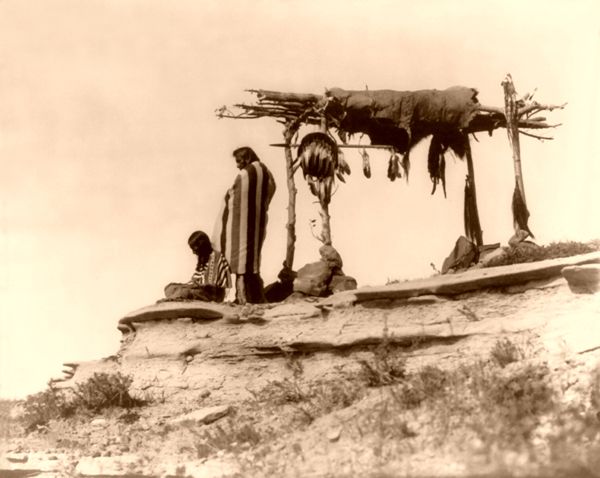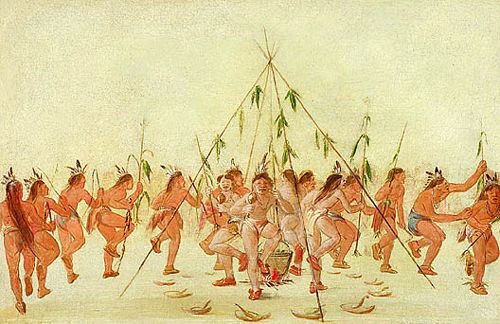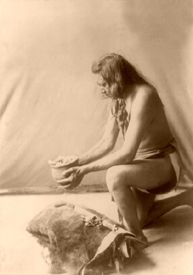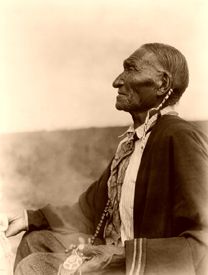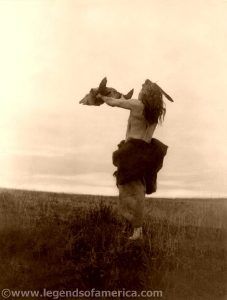Native American Rituals and Ceremonies – Legends of America (original) (raw)
Sun Dance ceremony by George Catlin
Ceremony and rituals have long played a vital and essential role in Native American culture. Spirituality is an integral part of their very being.
Often referred to as “religion,” most Native Americans did not consider their spirituality, ceremonies, and rituals as “religion” like Christians do. Rather, their beliefs and practices form an integral and seamless part of their very being. Like other aboriginal peoples around the world, their beliefs were heavily influenced by their methods of acquiring food – from hunting to agriculture. They also embraced ceremonies and rituals that provided power to conquer life’s difficulties, as well as events and milestones such as puberty, marriage, and death. Over the years, practices and ceremonies changed with tribes‘ needs.
Taos Indian with a peace pipe
The arrival of European settlers marked a major change in Native American culture. Some of the first Europeans the Indians would meet were often missionaries who viewed Native American Spirituality practices as worthless superstitions inspired by the Christian devil. These early missionaries then determined to convert the Native Americans to Christianity.
As more and more Europeans flooded North America, the United States and Canadian governments instituted policies to force Natives onto reservations and encourage them to assimilate into the majority culture.
This also changed their spiritual traditions when, in 1882, the U.S. Federal Government began to work towards banning Native American Religious Rights, which impacted their ceremonies. At that time, U.S. Interior Secretary Henry M. Teller ordered an end to all “heathenish dances and ceremonies” on reservations due to their “great hindrance to civilization.” This was further supported the following year by Hiram Price, Commissioner of Indian Affairs when his 1883 report stated:
“…there is no good reason why an Indian should be permitted to indulge in practices which are alike repugnant to common decency and morality, and the preservation of good order on the reservations demands that some active measures should be taken to discourage and, if possible, put a stop to the demoralizing influence of heathenish rites.”
These attempts to suppress the traditions of Native Americans eventually led to the Massacre at Wounded Knee on December 29, 1890, when the government attempted to stop the practice of the “Ghost Dance,” a far-reaching movement that prophesied a peaceful end to white American expansion and preached goals of clean living, an honest life, and cross-cultural cooperation by Native Americans.
When the Seventh U.S. Cavalry was sent into the Lakota Sioux’s Pine Ridge and Rosebud Reservations to stop the dance and arrest the participants, approximately 150 Native American men, women, and children were killed.
Though some traditions were lost, others survived despite the ban, and various tribes continue to follow many spiritual traditions. Some Native Americans have been devout Christians for generations, and their practices today combine their traditional customs with Christian elements. Other tribes, particularly in the Southwest, have mostly retained their aboriginal traditions.
Rituals & Ceremonies:
Tribute to the Dead
Death Ceremonies – Native Americans celebrated death, knowing it was an end to life on Earth but believing it to be the start of life in the Spirit World. Most tribes also believed that the journey might be long, so afterlife rituals were performed to ensure that the spirits would not continue to roam the earth. Various tribes honored the dead by giving them food, herbs, and gifts to ensure a safe journey to the afterlife.
The Hopi Indians believe that the soul moves along a Sky path westwards and that those who have lived a righteous life will travel with ease. However, those who haven’t will encounter suffering on their journey.
To ensure a safe journey, they wash their dead with natural yucca suds and dress them in traditional clothes.
Prayer feathers are often tied around the forehead of the deceased, and they are buried with favorite possessions and feathered prayer sticks. Traditional foods and special herbs are served and placed at the graveside.
The Navajo perceived that living to old age was a sign of a life well-lived, thus ensuring that the soul would be born again. Alternatively, they felt that if a tribe member died of sudden illness, suicide, or violence, a “Chindi, or destructive ghost, could cause trouble for the deceased’s family. Afterlife rituals could last for several days, with careful thought given to foods and herbs chosen for the celebration, reflecting how the deceased lived their life. Common herbs used by the Navajo included Broom Snake Weed, Soap Weed, and Utah Juniper.
Many tribes who had been converted to Catholicism also celebrated All Souls’ Day, each November 1st, which celebrates the dead. Many believe that the spirits return to visit family and friends on that day. In preparation, various tribes would prepare food and decorate their homes with ears of corn as blessings for the dead.
Green Corn Dance
Green Corn Festivals – Also called the Green Corn Ceremonies, this is both a celebration and religious ceremony primarily practiced by the peoples of the Eastern Woodlands and the Southeastern tribes, including the Creek, Cherokee, Seminole, Yuchi, Iroquois, and others. The ceremony typically coincides with the late summer and is tied to the ripening of the corn crops. Marked with dancing, feasting, fasting, and religious observations, the ceremony usually lasts for three days. Activities varied from tribe to tribe, but the common thread is that the corn would not be eaten until the Great Spirit was given his proper thanks. During the event, tribal members give thanks for the corn, rain, sun, and a good harvest. Some tribes even believe that they were made from corn by the Great Spirits. The Green Corn Festival is also a religious renewal, with various religious ceremonies. During this time, some tribes hold council meetings where many of the previous year’s minor problems or crimes are forgiven. Others also signify the event as the time of year when youth come of age, and babies are given their names. Several tribes incorporate ball games and tournaments in the event. Cleansing and purifying activities often occur, including cleaning out homes, burning waste, and drinking emetics to purify the body. At the end of each festival day, feasts are held to celebrate the good harvest. Green Corn festivals are still practiced today by many different native peoples of the Southeastern Woodland Culture.
Incense over a medicine bundle, by Edward S. Curtis, 1908
Healing Rituals – Symbolic healing rituals and ceremonies were often held to bring participants into harmony with themselves, their tribe, and their environment. Ceremonies were used to help groups of people return to harmony, but large ceremonies were generally not used for individual healing. Varying widely from tribe to tribe, some tribes, such as the Sioux and Navajo, used a medicine wheel and a sacred hoop and would sing and dance in ceremonies that might last for days.
Historic Indian traditions also used many plants and herbs as remedies or in spiritual celebrations, creating a connection with spirits and the afterlife. Some of these plants and herbs used in spiritual rituals included Sage, Bear Berry, Red Cedar, Sweet Grass, Tobacco, and many others.
The healing process in Native American Medicine is much different than how most of us see it today. Native American healing includes beliefs and practices combining religion, spirituality, herbal medicine, and rituals for medical and emotional conditions. From the Native American perspective, medicine is more about healing the person than curing a disease. Traditional healers worked to make the individual “whole,” believing that most illnesses stem from spiritual problems.
In addition to herbal remedies, purifying and cleansing the body is also important, and many tribes used sweat lodges for this purpose. In these darkened and heated enclosures, a sick individual might be given an herbal remedy, smoke or rub themselves with sacred plants, and a healer might use healing practices to drive away angry spirits and invoke the healing powers of others.
Sometimes healing rituals might involve whole communities, where participants would sing, dance, paint their bodies, and sometimes use mind-altering substances to persuade the spirits to heal the sick person.
Peyote Worship – Some southwest tribes have historically practiced Peyote ceremonies which were connected with eating or drinking of tea made of peyote buttons, the dried fruit of a small cactus, officially called Anhalonium or Laphophora. Native to the lower Rio Grande and Mexico, the name “mescal” was wrongly applied to this fruit by many white observers. The ceremonies were held for specific reasons including healing, baptism, funerals, and other special occasions. Though many have the impression that peyote was smoked, this was not the case, as the peyote button will not burn. Instead, fresh or dried buttons were eaten or ground into a powder and drank in tea.
Cheyenne Peyote Leader by Edward S. Curtis
Rites for these ceremonies would generally begin in the evening and continue until the following dawn and were restricted by some tribes only to men. Like other Indian ceremonies, fire and incense were used to cleanse the mind and body. The ceremony also utilized bird feathers, which represented bird power, preferably those from predator birds, which were strong and thought to protect the worshipper.
The ceremonies were guided by healers, also known as roadmen, as they were thought to guide a person’s journey through life. Most often, small drums and rattles were also utilized. The experience is almost identical to taking lysergic acid diethylamide, better known as LSD.
Called the “sacred medicine,” peyote ceremonies are still practiced today by various tribes who believe that it counters the craving for alcohol, heals and teaches righteousness, and is useful in combating spiritual, physical, and other social ills. Concerned about the drug’s psychoactive effects, between the 1880s and 1930s, U.S. authorities attempted to ban Native American religious rituals involving peyote, including the Ghost Dance. Today, the Native American Church is among several religious organizations that use peyote as part of its religious practice.
Pow-Wows – A relatively modern word, the term derives from the Narragansett word “powwaw,” which means “spiritual leader.” Before the term “pow-wow” became popular, other words were used to describe these gatherings, such as celebration, doing, fair, feast, festival, and more. The closest English translation is “meeting.” Today, it exemplifies all of these events, and a modern pow-wow can be any event where both Native American and non-Native American people meet to dance, sing, socialize, and honor American Indian culture. These events might be specific to a certain tribe or inter-tribal.
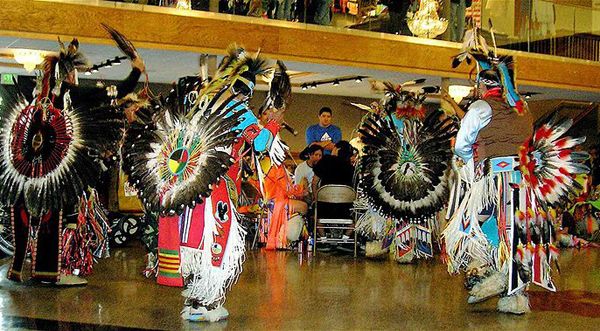
Native American PowWow
Planning for a pow-wow generally begins months before the event by a group of people, usually called a pow-wow committee, and may be sponsored by a tribal organization, tribe, or any other organization that wishes to promote Native American culture. These events almost always feature dance events, some of which are competitive and can last from hours to several days.
The Gathering of Nations is one of the largest Pow-wows in the United States. It is held annually on the fourth weekend in April in Albuquerque, New Mexico. Over 500 tribes from around the United States and Canada participate. This event is competitive with 32 dance categories, other competitions for singers and drumming and a pageant for Miss Indian World. The event also features a Traders’ Market where Native Americans display their arts and crafts.
Mandan offering the buffalo skull
Vision Quests – Numerous Native Americans practiced the rite of Vision Quests, often taken by older children before puberty to “find themselves” and their life’s direction. How the rite was taken, its length and intensity, and at what age varied greatly from tribe to tribe. In most cases, the vision quest was a “supernatural” experience in which the individual seeks to interact with a guardian spirit, usually an animal, to obtain advice or protection.
Much preparation was often taken before the vision quest was undertaken to determine the sincerity and commitment of the person. Sometimes the quest required the individual to go alone into the wilderness for several days to become attuned to the spirit world.
Other tribes required the individual to take a long walk or were confined to a small room. Often the individual was required to fast before the quest and was not allowed to sleep. During this period of sensory deprivation, the individual was to search for a guardian spirit’s presence or a sign that would be given to them. Once the presence or sign was “seen,” and the individual had realized his/her direction in life, they would return to the tribe to pursue their life’s journey.
© Kathy Alexander/Legends of America, updated March 2023.
See our Rituals, Ceremonies & Dances Photo Gallery HERE
Also See:
Native Americans – First Owners of America
Native American Photo Galleries
